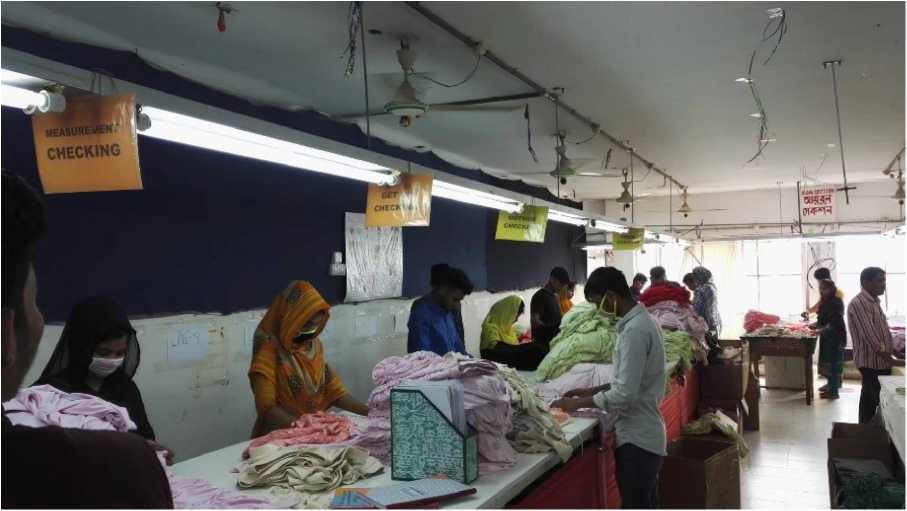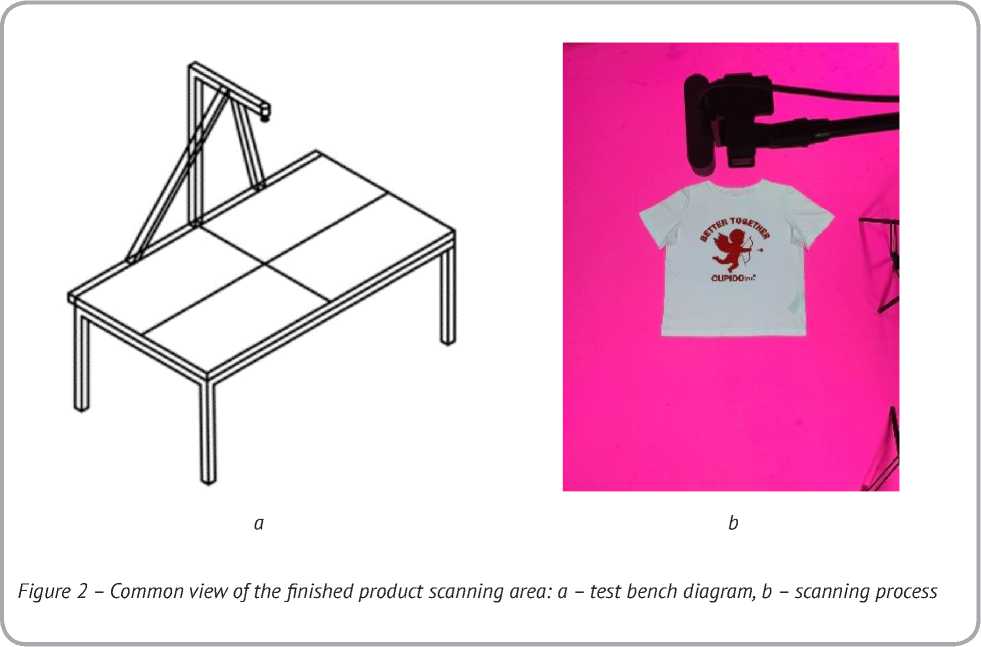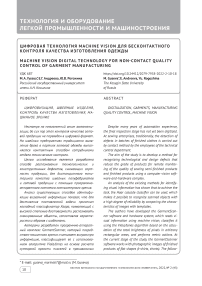Machine vision digital technology for non-contact quality control of garment manufacturing
Автор: Guseva Marina, Andreeva Elena, Rogozhina Yuliya
Журнал: Вестник Витебского государственного технологического университета @vestnik-vstu
Рубрика: Технология и оборудование легкой промышленности и машиностроения
Статья в выпуске: 2 (43), 2022 года.
Бесплатный доступ
Despite many years of automation experience, the final inspection stage has not yet been digitized. At sewing enterprises, traditionally, the detection of defects in batches of finished clothes is carried out by contact method by the employees of the technical control department. The aim of the study is to develop a method for recognizing technological and design defects that reduce the grade of products for remote monitoring of the quality of sewing semi - finished products and finished products using a computer vision software - and - hardware complex. An analysis of the existing methods for identifying visual information has shown that to achieve the task, the Haar cascade classifier can be used, which makes it possible to recognize scanned objects with a high degree of reliability by comparing the characteristics of images with templates. The authors have developed the GarmentScanner software and hardware system, which reads visual information using machine vision, classifies it using the Viola/Jones algorithm based on the calculation of the total brightness of pixels in arbitrary rectangular areas, and performs metric actions. At the current stage of the study, the GarmentScanner software works with photographic images of finished products of flat shapes (t - shirts, shorts). The following attributes were selected as the tested attributes: the coordinates of the base and reference points on the product (in accordance with the model features); the symmetry of the contour; the conformity of the dimensions of a particular model to the reference sample (according to the table of measures). Approbation of GarmentScanner work is carried out at outsourcing sewing enterprises in China, cooperating with Russian design agencies. An additional effect from the use of GarmentScanner was the reduction of conflict situations in production, arising against the background of different interpretations by customers from Russia and outsourcing contractors of the concept of "production quality and its rejection".
Digitalization, garments, manufacturing quality control, machine vision
Короткий адрес: https://sciup.org/142236073
IDR: 142236073 | УДК: 687 | DOI: 10.24412/2079-7958-2022-2-10-18
Текст научной статьи Machine vision digital technology for non-contact quality control of garment manufacturing
Российский государственный университет имени А.Н. Косыгина
The priority task facing society is the widespread adoption of digital technology, both in industry and in “information processing and storage and access to knowledge” [1]. The modern stage of technology development is called the Fourth Industrial Revolution. The main distinction of the newest technological breakthroughs was the introduction of robotic flow production and the widespread replacement of computing operations (information collection and processing) by computer systems. The transformation of the classic technologies of the "machine revolution of the twentieth century" into a digital environment embraced many industries. Digitalization and automation of production processes are widespread in such industries as electronics, automotive and aircraft design, pharmaceuticals, and the production of food semi-finished products [2].
In conveyorized production environments, quality control has been entrusted to automated machine vision systems. With the introduction of the computer method of scanned information processing, the productivity of flow production and the detectability of defects has increased significantly. Hardware-and-software systems read visual information, classify it, and perform metric operations. Robots process information from video sequences or scans of objects much faster than the factory staff, with an accuracy that is inaccessible to humans. At the same time, the computer program is trained to perform actions similar to the thinking activity of the human brain when analyzing images [3]. The software apparatus of modern machine vision complexes is an artificial intelligence, capable of adapting to the tasks at hand, programmed to be teachable [4]. Software intellectualization is based on the use of the method of processing the input information using neural networks [5], when the video sequence or a set of scans-copies is divided by the program toolkit into many blocks and layers [6] with subsequent complex systematization and provision of output parameters in accordance with the purpose of research, i.e., identification.
The most common method of object recognition by computer vision is based on comparing image characteristics with templates [7]. The essence of the method is that the computer program algorithm compares frame-by-frame images of video sequences with information stored in a database about variants of configuration of an object as a whole, its parts and positioning of informative points [8], about background, color combinations inside the object, etc. At the output the operator of the hardware-and-software complex of machine vision receives the conclusion about the presence of the object in a particular digital video or photogrammetry, or confirmation of its absence, the characteristic of the parameters within the framework of the task. This method of identification is used in programs to recognize license plates; text in general and handwriting, in particular; as well as subjects (confirmation of identity).
The execution of an image recognition procedure by a computer program is a complex task based on machine learning. Efficient ways of detection are cascade Haar classifiers [9]. Program training is based on the analysis of pixel images with positive (presence of an object) and negative (absence of an object) search features. The Haar features (filters) are positioned in rectangular black and white areas. The computer program moves the search area in the image, summarizes the pixel intensity in each area, and calculates the difference between the sums in the black and white areas, which is the desired parameter.
Identification of objects/subjects by machine vision is successfully used in modern security systems, in video traffic surveillance, in store windows, in bank terminals, and in forensics. Current state of the problem
The process of garment production automation began in the second half of the twentieth century. Information technologies are successfully used in the process of clothing design (design, modeling, grading), at the stages of cutting and technological preparation. Video is used to analyze the quality of thread joints in seams by a computer program [10]. Designers master three-dimensional sketching [11] and virtual fitting [12]. With the spread of the Internet, the availability of scanning equipment, and the development of applied information technologies, the use of machine vision for assessing the quality of garment production becomes promising [13].
Modern clothing production, like many other industries, is subject to the laws of the market. More than 30 years ago, with the consolidation of outsourcing in the international system of labor’s division, there was a territorial division of manufacturing firms and design agencies. There appeared companies-contractors specializing in the preparation and execution of orders in certain phases of sewing production. The most common outsourcing firms are in China, India, Pakistan, Bangladesh, Myanmar, Vietnam. Russian fashion design agencies actively cooperate with outsourcing contractors. The advantage of such a tandem is the availability of labor resources and high-tech cutting and sewing equipment at outsourcing firms.
With the attraction of outsourcing specialists from Asian countries to the fashion business, the Russian clothing market has been filled with Fast fashion products. Many Fast fashion clothing models are characterized by uncomplicated shaping and simple execution. Therefore, sewing outsourcing companies, at times, recruit low-skilled staff to the workshops. This approach is often accompanied by miscommunication in the issues of interpreting the quality of production and its rejection between customers from Russia and outsourcing contractors [14]. Traditionally, at clothing companies the detection of defects in batches of finished clothing is performed in a contact manner by employees of the technical control department (Figure 1). The work of a QCD inspector is associated with physical and emotional stress. Frequent change of assortment, significant volumes of production batches lead to rapid fatigue of the person, the inspector loses sharpness of vision, which leads to inadequate inspection and appearance of defective products in the batch of industrial products. Outsourcing cooperation includes visits to factories by Russian technologists. The technologist inspector checks the entire technological process, and especially the quality control stage of finished products. Interethnic differences in attitudes toward labor and language barriers are the main factors that complicate the activities of a technologist inspecting an outsourcing sewing company.
The aim of the study is to develop a method for recognizing technological and design defects that reduce the grade of products for remote monitoring of the quality of sewing semi-finished products and finished products using a computer vision software-and-hardware complex.

Figure 1 –
Garment Quality Control Department (Bangladesh)
The authors propose an innovative way of noncontact quality control of garment manufacturing using computer vision software and hardware. This impersonal method of control is aimed not only at reducing conflict situations in outsourcing production, but also at optimizing production – machine vision can detect technological and design defects that reduce the grade of products. Method of research
In the study presented, the capabilities of hardware computing, basics of metrology, elements of basic theory on computer image processing, postulates of analytical geometry and vector algebra, knowledge from areas of computer graphics are applied.
Research result
The GarmentScanner machine vision hardware and software package [15] developed by the authors is an innovative product that has no analogues in Russia. The program algorithm is written in OpenCV, compiled on the .NET platform, used by the Python program. The purpose of GarmentScanner is to detect technological defects in the production of flat-shaped garments by photo-images of objects. The recognition tool is the neural network model of image analysis using Haar cascades. The program algorithm includes the following stages: computational operations to determine the coordinates of informative points and parameters of the sections of the objects under study; calculation of the position of the symmetry axis of the products; coding of the contour of each model sample.
GarmentScanner software works with the photo images of the finished products of flat shapes (T-shirts, underpants). The initial task of the program is to analyze the images by machine vision, detect and remove defective scans or "noises". To train the system, databases containing images of technological defects [16] and digital measurement scales [17] of research objects have been developed. In the course of express monitoring conducted by the authors at outsourced enterprises, it was found that the most significant technological defects that can be identified by machine vision are:
-
1. Non-compliance of measurements affecting the fit of the ready garment.
-
2. Curve neckline.
-
3. Curve bottom.
-
4. Different sleeves length.
-
5. Curve stitch.
-
6. Broken stitch.
-
7. Dirty spots.
-
8. Fabric defects.
-
9. Different length of side seams.
-
10. Asymmetric print.
In accordance with the experiment plan, to rank the identified groups of defects on a 10-point scale, experts-technologists, controllers of the clothing factories, representatives of design agencies and trade organizations were involved. It was found that the most significant, reducing the quality of products are "Non-compliance of measurements affecting the fit of the ready garment" (8.5 points), "Curve neckline" (8.1 points), Different sleeves length (6.5 points), "Curve bottom" (5.5 points). Therefore, the GarmentScanner algorithm includes functions to identify technological defects associated with the asymmetry of products acquired during manufacturing.
The process of scanning finished products by the GarmentScanner computer vision system is performed on a specially designed stand (Figure
-
2), including: a tabletop; a webcam and a tripod for fixing it; additional light sources; a computer; a server.
The functions of GarmentScanner were tested at the outsourcing company "Far East" (PRC). The cascade model of clothes scan recognition sequentially activates various classifiers, which allows the program to accurately parameterize products (Figure 3). The attributes to be tested are the following: coordinates of base and reference points on the product (in accordance with the model features); the symmetry of the contour; the correspondence of the dimensions of a particular model to the reference sample (according to the table of measures).
To form the adequacy of GarmentScanner, special attention is paid to the stage of searching for the background color solution for scan image positioning. It has been empirically established that a bright acid pink shade of the background is the most acceptable, as this color is the least used in coloring materials for modern industrial collections of Fast fashion clothes. The choice of color contrast for the background and the

-
■9 Garmentscanner — □
Файл Камеры Вид Окна Процесс Справка
Список литературы Machine vision digital technology for non-contact quality control of garment manufacturing
- Schwab, K. (2016), The Fourth Industrial Revolution (Top Business Awards), Eksmo, 138 p.
- Steger, C., Ulrich, M., Wiedemann, C. (2018), Machine Vision Algorithms and Applications, Weinheim:Wiley-VCH Verlag GmbH & Co, 516 p.
- Dai, W., Dai, C., Ou, S., Li, J., Das, S. (2017), Very deep convolutional neural networks for raw waveforms, Proceedings of the 2017 IEEE International Conference on Acoustics, Speech and Signal Processing, 2017, pp. 421-425.
- Hopfield, J. J. (1982), Neural networks and physical systems with emergent collective computational abilities, Proceedings of the National Academy of Sciences of the United States of America, 1982, Vol. 79, Is. 8., pp. 2554-2558.
- Yosinski, J., Clune, J., Nguyen, A., Fuchs, T., Lipson, H. (2015), Understanding neural networks through deep visualization, Proceedings of International Conference on Machine Learning, Deep Learning Workshop, 2015, p. 12.
- Brown, L. (1992), A survey of image registration techniques, Proceedings of ACM Computing Surveys, 1992, Vol. 24, № 1, pp. 325-376.
- NaziL, P., Darshan, K., Ishan, B. (2013), An overview on template matching methodologies and its applications, International Journal of Research in Computer and Communication Technology, 2013, VoL. 2, № 10, p. 988-995.
- Foresight, D., Pons, J. (2018), Компьютерное зрение. Современный подход, Москва, 2018, 960 p.
- Viola, P., Jones, M. (2001), Rapid object detection using a boosted cascade of simple features, Proceedings of IEEE Computer Society Conference on Computer Vision and Pattern Recognition, 2001, Vol. 1, pp. 511-518.
- Шеромова, И. А., Старкова, Г. П., Дремлюга, О. А. (2016), Применение компьютерных технологий при оценке качества ниточных соединений, Современные наукоёмкие технологии. Технические науки, 2016, № 12, с. 299-303.
- Алибекова, М. И., Белгородский, В. С., Андреева, Е. Г. (2021), Инновационные технологии в эскизном и художественном проектировании объемных форм костюма, Известия высших учебных заведений. Технология текстильной промышленности, 2021, № 3, с. 102-106.
- Petrosova, I. A., Andreeva, E. G., Guseva, M. A. (2019), The system of selection and sale of ready-to-wear clothes in a virtual environment, International Science and Technology Conference "EastConf", Vladivostok, Russia, 2019, pp. 1-5. doi: 10.1109/EastConf.2019.8725390.
- Rogozhina, Iu., Guseva, M., Andreeva, E. (2022), Garment Production Quality Evaluation Using Machine Vision, Proceeding of the International Science and Technology Conference "FarEastCon
- Sheromova, I. A., Starkova, G. P., DremLyuga, O. A. (2016), Application of computer technologies in assessing the quality of thread connections [Primenenie komp'juternyh tehnoLogij pri ocenke kachestva nitochnyh soedinenij], Modern science-intensive technologies Technical sciences, 2016, № 12, pp. 299-303.
- ALibekova, M. I., BeLgorodsky, V. S., Andreeva, E. G. (2021), Innovative technologies in sketch and artistic design of three-dimensionaL costume forms [Innovacionnye tehnoLogii v jeskiz-nom i hudozhestvennom proektirovanii obemnyh form kostjuma], Izvestiya Vysshikh Uchebnykh Zavedenii, Seriya Teknologiya Tekstil-noi Promyshlennosti, 2021, № 3, pp. 102-106.
- Petrosova, I. A., Andreeva, E. G., Guseva, M. A. (2019), The system of seLection and saLe of ready-to-wear cLothes in a virtuaL environment, International Science and Technology Conference "EastConf", Vladivostok, Russia, 2019, pp. 1-5. doi: 10.1109/EastConf.2019.8725390.
- Rogozhina, Iu., Guseva, M., Andreeva, E. (2022), Garment Production OuaLity Evaluation Using Machine Vision, Proceeding of the International Science and Technology Conference "FarEastCon 2021". Smart Innovation, Systems and Technologies, 2019, vol. 275, Springer, Singapore. https://doi. org/10.1007/978-981-16-8829-4_27
- Гусева, М. А., Гетманцева, В. В., Андреева, Е. Г, Рогожина, Ю. В., Смирнов, В. Б. (2020), Цифро-визация дефектов одежды для оптимизации аутсорсингового изготовления «Fast Fashion» коллекций, Дизайн и технологии, 2020, № 75 (117), с. 36-44.
- Рогожина, Ю. В., Гусева, М. А., Андреева, Е. Г., Белгородский, В. С., Данильченко, А. О., Слободян, М. В. (2021), GarmentScanner, Свидетельство о регистрации программы для ЭВМ № 2021617946 RUS. Опубл. 20.05.2021, бюл. № 5.
- Рогожина, Ю. В., Гусева, М. А., Андреева, Е. Г., Белгородский, В. С., Глебова, Т. Г. (2020), Базовые цифровые шкалы технологических дефектов швейных изделий, определяемых техническими средствами идентификации, Свидетельство о регистрации базы данных № 2020621712 RUS, опубл. 18.09.2020, бюл. № 9.
- Гусева, М. А., Рогожина, Ю. В., Андреева, Е. Г., Белгородский, В. С., Глебова, Т. Г. (2020), Цифровые шкалы измерений швейных изделий для автоматизированного контроля качества, Свидетельство о регистрации базы данных № 2020622292 RUS, опубл. 16.11.2020, бюл. № 11.


